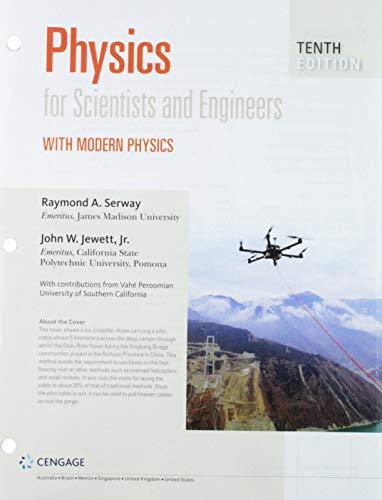
Four resistors are connected to a battery as shown in Figure P27.15. (a) Determine the potential difference across each resistor in terms of ε. (b) Determine the current in each resistor in terms of I. (c) What If? If R3 is increased, explain what happens to the current in each of the resistors. (d) In the limit that R3 → ∞, what are the new values of the current in each resistor in terms of I, the original current in the battery?
Figure P27.15
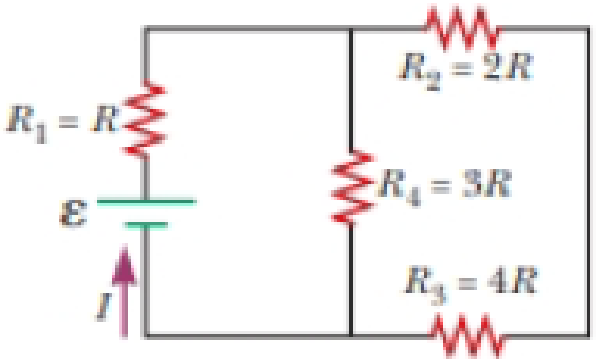
(a)
The potential difference across each resistor in terms of
Answer to Problem 15P
The potential difference across
Explanation of Solution
The resistors
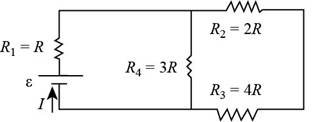
Figure (1)
Formula to calculate the resistance across the circuit when resistors
Here,
Substitute
Thus, the resistance across the circuit when resistors
The resistors
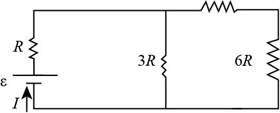
Figure (2)
Formula to calculate the resistance when the resistors are connected in parallel is,
Here,
Substitute
Thus, the value of the resistance when the resistors are connected in parallel is
The resistors
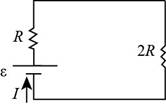
Figure (3)
Formula to calculate the equivalent resistance across the circuit is,
Here,
Substitute
Thus, the equivalent resistance across the circuit is
The equivalent resistance is shown in the figure 4.
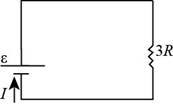
Figure (4)
Formula to calculate the current across the circuit is,
Here,
Substitute
Thus, the current across the circuit is
Formula to calculate the voltage across the
Here,
Substitute
Thus, the voltage across the
Thus, the voltage across the
Formula to calculate the voltage across the
Here,
Substitute
Thus, the voltage across the
Formula to calculate the current across the
Here,
Substitute
Thus, the current across the
Formula to calculate the current across the
Here,
Substitute
Thus, the current across the
Formula to calculate the voltage across the
Here,
Substitute
Thus, the voltage across the
Formula to calculate the voltage across the
Here,
Substitute
Thus, the voltage across the
Conclusion:
Therefore, the potential difference across
(b)
The current in each resistor in terms of
Answer to Problem 15P
The current across
Explanation of Solution
Formula to calculate the value of
Substitute
Thus, the value of
Formula to calculate the current across the
Here,
Substitute
Substitute
Thus, the current across the
Formula to calculate the current across the
Here,
Substitute
Substitute
Thus, the current across the
Formula to calculate the current across the
Here,
Substitute
Substitute
Thus, the current across the
Formula to calculate the current across the
Here,
Substitute
Substitute
Thus, the current across the
Conclusion:
Therefore, the current across
(c)
The effect in the current in each of the resistors, if
Answer to Problem 15P
The value of current across
Explanation of Solution
If the value of the
Since, the current remains same in series combination. So, the value of current across
If the value of the
Thus, the current across the
Conclusion:
Therefore, the value of current across
(d)
The new values of the current in each resistor in terms of
Answer to Problem 15P
The current across
Explanation of Solution
If
Here,
The resistors
Formula to calculate the resistance across the circuit when resistors
Here,
Substitute
Thus, the resistance across the circuit when resistors
From equation (11), the value of
From equation (12), formula to calculate the current across the
Here,
Substitute
Thus, the current across the
As the resistors
Here,
Thus, the original current in the battery is
Conclusion:
Therefore, the current across
Want to see more full solutions like this?
Chapter 27 Solutions
Bundle: Physics For Scientists And Engineers With Modern Physics, Loose-leaf Version, 10th + Webassign Printed Access Card For Serway/jewett's Physics For Scientists And Engineers, 10th, Single-term
Additional Science Textbook Solutions
Cosmic Perspective Fundamentals
Biochemistry: Concepts and Connections (2nd Edition)
Fundamentals Of Thermodynamics
Applications and Investigations in Earth Science (9th Edition)
- Question 6: Chlorine is widely used to purify municipal water supplies and to treat swimming pool waters. Suppose that the volume of a particular sample of Cl₂ gas is 8.70 L at 895 torr and 24°C. (a) How many grams of Cl₂ are in the sample? ⚫ Atomic mass of CI = 35.453 g/mol • Molar mass of Cl₂ = 2 x 35.453 = 70.906 g/mol Solution: Use the Ideal Gas Law: Step 1: Convert Given Values • Pressure: P = 895 torr → atm PV= = nRT 1 P = 895 × = 1.1789 atm 760 • Temperature: Convert to Kelvin: T24273.15 = 297.15 K • Gas constant: R = 0.0821 L atm/mol. K Volume: V = 8.70 L Step 2: Solve for n . PV n = RT n = (1.1789)(8.70) (0.0821)(297.15) 10.25 n = = 0.420 mol 24.405 Step 3: Calculate Mass of Cl₂ Final Answer: 29.78 g of Cl₂. mass nx M mass= (0.420)(70.906) mass= 29.78 garrow_forwardE1 R₁ w 0.50 20 Ω 12 R₁₂ ww ΒΩ R₂ 60 E3 C RA w 15 Ω E2 0.25 E4 0.75 Ω 0.5 Ωarrow_forwardSolve plzarrow_forward
- how would i express force in vector form I keep getting a single numberarrow_forwardplease help me solve this questions. show all calculations and a good graph too :)arrow_forwardWhat is the force (in N) on the 2.0 μC charge placed at the center of the square shown below? (Express your answer in vector form.) 5.0 με 4.0 με 2.0 με + 1.0 m 1.0 m -40 με 2.0 μCarrow_forward
- What is the force (in N) on the 5.4 µC charge shown below? (Express your answer in vector form.) −3.1 µC5.4 µC9.2 µC6.4 µCarrow_forwardAn ideal gas in a sealed container starts out at a pressure of 8900 N/m2 and a volume of 5.7 m3. If the gas expands to a volume of 6.3 m3 while the pressure is held constant (still at 8900 N/m2), how much work is done by the gas? Give your answer as the number of Joules.arrow_forwardThe outside temperature is 25 °C. A heat engine operates in the environment (Tc = 25 °C) at 50% efficiency. How hot does it need to get the high temperature up to in Celsius?arrow_forward
 Physics for Scientists and EngineersPhysicsISBN:9781337553278Author:Raymond A. Serway, John W. JewettPublisher:Cengage Learning
Physics for Scientists and EngineersPhysicsISBN:9781337553278Author:Raymond A. Serway, John W. JewettPublisher:Cengage Learning Physics for Scientists and Engineers with Modern ...PhysicsISBN:9781337553292Author:Raymond A. Serway, John W. JewettPublisher:Cengage Learning
Physics for Scientists and Engineers with Modern ...PhysicsISBN:9781337553292Author:Raymond A. Serway, John W. JewettPublisher:Cengage Learning Principles of Physics: A Calculus-Based TextPhysicsISBN:9781133104261Author:Raymond A. Serway, John W. JewettPublisher:Cengage Learning
Principles of Physics: A Calculus-Based TextPhysicsISBN:9781133104261Author:Raymond A. Serway, John W. JewettPublisher:Cengage Learning Physics for Scientists and Engineers, Technology ...PhysicsISBN:9781305116399Author:Raymond A. Serway, John W. JewettPublisher:Cengage Learning
Physics for Scientists and Engineers, Technology ...PhysicsISBN:9781305116399Author:Raymond A. Serway, John W. JewettPublisher:Cengage Learning
 Physics for Scientists and Engineers: Foundations...PhysicsISBN:9781133939146Author:Katz, Debora M.Publisher:Cengage Learning
Physics for Scientists and Engineers: Foundations...PhysicsISBN:9781133939146Author:Katz, Debora M.Publisher:Cengage Learning





